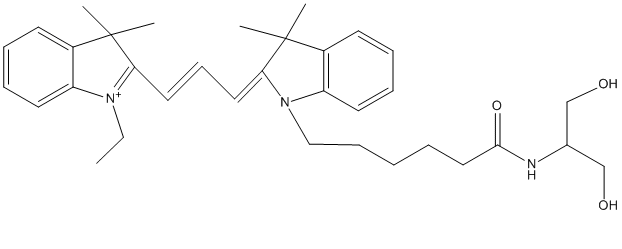Quasar 670 CPG Column
Quasar 670 CPG Column
Key features
Show- Used to add a red fluorescent dye to the 3' end of an oligonucleotide.
- Maximal emission around 670 nm. Alternative to cyanine-5.
- Quenched by BHQ-2.
- 500 Å CPG suitable for high yield applications such as therapeutic oligos (≤ 30mers).
Product information
Cyanine-based dyes have been used for many years in areas such as textiles. Their application in nucleic acid labelling (1) increased firstly with their commercial availability as succinimidyl esters, then latterly as phosphoramidites. Today they are a central part of many diagnostic platforms and assays based on fluorophore labelling and detection. Cyanine dyes are used as fluorescent markers in oligonucleotide synthesis,(2) primarily for molecular diagnostics such as the preparation of probes used in monitoring real-time PCR, fluorescence in situ hybridisation (FISH) and in Surface-Enhanced Resonance Raman Spectroscopy (SERRS) based DNA detection assays. Their emission spectra can be tuned by altering the length of the polymethine chain and solubility in organic or aqueous solvents can be altered via the substituents on the aromatic ring. The most commonly used classic phosphoramidite dyes are Cyanine-3 and Cyanine-5 (structurally equivalent to Cy™ 3 and Cy™ 5. These are generally attached to the 5'-end of an oligonucleotide during synthesis, however are easily incorporated within the sequence.
The MMT-protected hydroxyl group is removed in the same way as DMTr protection. Internal incorporation is not common due to the lack of heterocyclic base in their structure and as such they do not have the ability to participate in base pairing. This destabilises any duplexes formed. For 3'-attachment, we have introduced the equivalent 3'-modified CPG supports. Previously this was done by adding the dye post- synthetically onto an amino-modified oligonucleotide or by adding the amidite to a support functionalised with a modification that will not interfere with the use of the oligonucleotide (e.g. phosphate, spacer). 3'-Labelling is particularly useful in FRET where the FRET partner is incorporated either at the 5'-end or within the oligonucleotide sequence.(3) LGC Biosearch Technologies' series of Quasar™ dyes were developed as direct replacements for the Cy™ 3, Cy™ 5 and Cy™ 5.5 dyes; Quasar 570, Quasar 670 and Quasar 705, with emission maxima at 570, 670 and 705 nm, respectively. Quasar dyes increase fluorophore choices and help eliminate potential cross-talk problems associated with multiplex qPCR. They are efficiently quenched by BHQ-2 or BHQ-3, and can be used in many different probe formats. Multiplex suggestions and PCR instrument compatibility of Quasar dyes can be found at our multiplex qPCR webpage. Quasar CPG and phosphoramidites are available for direct labelling of oligonucleotides. Active esters are available for coupling to amine groups on substrates such as proteins, peptides and oligonucleotides. The carboxy acid variants are used to label peptides, oligonucleotides or functionalized amines.
Ref:
- Molecular Probes Based on Cyanine Dyes for Nucleic Acid Research, T.G. Deligeorgiev, p125, in Near Infrared Dyes for High Technology Applications, Ed. S. Daehne, U. Resch-Genger and O. Wolfbeis, NATO ASI Series Publ., Kluwer Academic, 1998.
- Fluorescence based strategies for genetic analysis, R.T. Ranasinghe and T. Brown, Chem. Commun., 5487- 5502, 2005.
- Fluorescence resonance energy transfer in near-infrared fluorescent oligonucleotide probes for detecting protein-DNA interactions, S. Zhang, V. Metelev, D. Tabatadze, P.C. Zamecnik, A. Bogdanov Jr, Proc. Natl. Acad. Sci. USA, 105, 4156-4161, 2008.
|
Synthesizer
|
Column
|
Type/Description
|
Notes
|
|---|---|---|---|
|
MerMade 6,12
|
MerMade, syringe (all scales)
|
Pipette type column
|
A MerMade column is also known as a Supercolumn
|
|
MerMade 4, 48X, 96E, 192E, 192X
|
MerMade, Syringe (up to 1.3 mL)
|
Pipette type column
|
A MerMade column is also known as a Supercolumn
|
|
ABI 384 / 394
|
Luer
|
Barrel column with luer fitting at either end
|
Also known as ALL-FIT or Standard
|
|
Expedite 8909
|
Luer
|
Barrel column with luer fitting at either end
|
Also known as ALL-FIT or Standard
|
|
ABI3900
|
MerMade
|
Pipette type column
|
A MerMade column is also known as a Supercolumn
|
|
K&A H4, H8, H8SE, H2, H32, H64
|
Luer
|
Barrel column with luer fitting at either end
|
Also known as ALL-FIT or Standard
|
|
K&A S4CL/S8CL
|
Luer
|
Barrel column with luer fitting at either end
|
Also known as Standard. For this instrument, we recommend the Luer (Standard) column as the ALL-FIT columns have a wider barrel.
|
|
Dr Oligo 48
|
MerMade
|
Pipette type column
|
A MerMade column is also known as a Supercolumn
|
|
Dr Oligo 192XLc, 768XLc just plates
|
MerMade, Syringe (up to 1.3 mL)
|
Pipette type column
|
A MerMade column is also known as a Supercolumn
|
|
OligoMaker X12, 48, 192, X192, X96
|
MerMade, Syringe (up to 1.3 mL)
|
Pipette type column
|
A MerMade column is also known as a Supercolumn
|
Properties:
- Appearance: blue powder
- Absorption Maximum (Lambda Max): 644
- Extinction Coefficient at Lambda max: 187000
- Extinction Coefficient at 260 nm: 2800
- Fluorescence Maximum: 670
Product usage:
- Cleavage conditions: Use concentrated ammonia for 45 minutes at 25 °C.
- Deprotection conditions: When using fast deprotecting amidites (eg. C-Ac, G-DMF, G-PAC) use concentrated NH4OH for 5 hours at 25 °C. When using standard amidites (eg. C-Bz, G-iBu) deprotect in concentrated NH4OH for 12 hours at room temperature. Some degradation may occur. Dye conjugates are light sensitive and must be protected from unnecessary exposure.Image of cleaved and deprotected structure:
- The mass this product adds after conjugation and work-up (the additional mass seen by mass spectrometry) is: 632.74

Storage and handling:
- Shipping conditions: Ambient
- Storage conditions: -15 to -30 °C in sealed container
Access support
Need some support with placing an order, setting up an account, or finding the right protocol?
Contact us